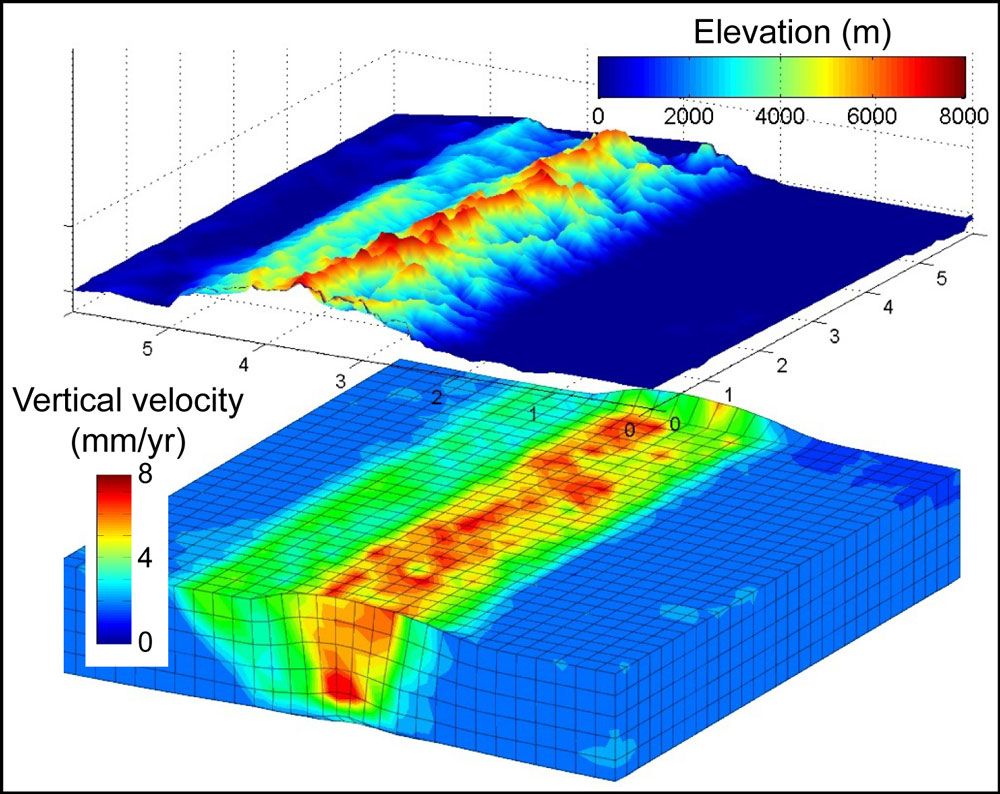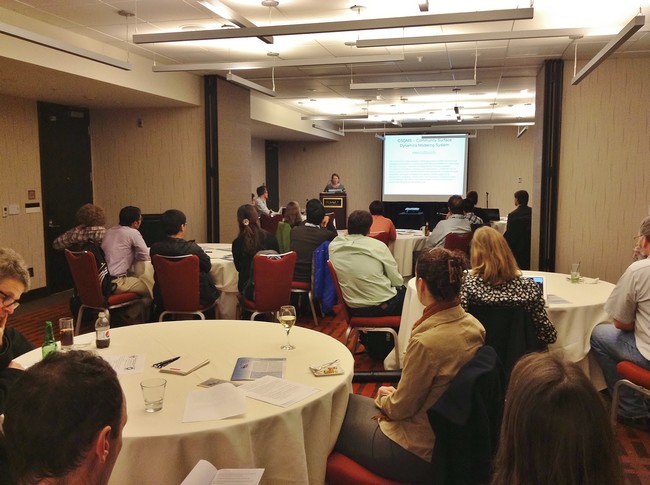Wednesday, December 11, 2013, 6:00 – 9:00 pm
Conveners: Phaedra Upton, Mark Behn, John Jaeger
6.00 | Refreshments and posters
6.45 – 7.15 | Introduction to the CSDMS Geodynamics Focus Research Group – Phaedra Upton and Mark Behn
- The Community Surface Dynamics Modeling System: Infrastructure Updates and EKT – Irina Overeem
- Quantifying controls of river erosion on geodynamic timescales – Brian Yanites
- Lessons learned from trying to couple Underworld and LeCodeb – Louis Moresi and Guillaume Duclaux
8:00-9:00 | Discussion led by Upton/Behn/Jaeger addressing the implementation plan
9:00 | Adjourn
 The goal of this mini-workshop is to discuss the availability and performance of community modeling codes for coupling geodynamics and surface processes. The workshop is motivated by the recent formation of the Geodynamics Focus Research Group within the Community Surface Dynamic Modeling System (CSDMS), which is co-sponsored by GeoPRISMS. The Geodynamics FRG was formed with the aim of understanding the interplay between climatic, geomorphic, and geological/tectonic processes in governing Earth surface processes and landscape evolution. A primary goal of the Geodynamics FRG is to move toward an integrated-coupled modeling suite that has the capability to account for paleo-topography, geology, substrate lithology, crustal deformation, climate, vegetation, runoff production, and ensuing sediment transport and storage.
The goal of this mini-workshop is to discuss the availability and performance of community modeling codes for coupling geodynamics and surface processes. The workshop is motivated by the recent formation of the Geodynamics Focus Research Group within the Community Surface Dynamic Modeling System (CSDMS), which is co-sponsored by GeoPRISMS. The Geodynamics FRG was formed with the aim of understanding the interplay between climatic, geomorphic, and geological/tectonic processes in governing Earth surface processes and landscape evolution. A primary goal of the Geodynamics FRG is to move toward an integrated-coupled modeling suite that has the capability to account for paleo-topography, geology, substrate lithology, crustal deformation, climate, vegetation, runoff production, and ensuing sediment transport and storage.
(4) discussing how to build on these existing codes to develop a robust coupled geodynamic-landscape evolution model(s) within the CSDMS framework. To facilitate these discussions we have invited 3 speakers to give short presentations on various aspects of community codes and problems in coupling tectonics and landscape evolution. However, the majority of the workshop will be set aside for open discussion on how best to build, benchmark, and disseminate a coupled community model.
Exploring the Interplay between Solid Earth Tectonics and Surface Processes using Community Codes Mini-Workshop
AGU Fall Meeting 2013, San Francisco, USA
Conveners: Phaedra Upton1, Mark Behn2, John Jaeger3
1GNS Science, New Zealand; 2Woods Hole Oceanographic Institution; 3University of Florida
About 30 scientists with a wide range of interests spanning field-based to modeling studies, spent the Wednesday night of AGU at the Grand Hyatt San Francisco exploring the interplay between solid Earth tectonics and surface processes with an emphasis on using community codes. The workshop was associated with AGU sessions EP33B and EP43E/44A, sponsored by GeoPRISMS, and supported by the Community Surface Dynamics Modelling System (CSDMS). The workshop was prompted by the inclusion of a new Geodynamics Focus Research Group into CSDMS 2.0, co-chaired by Phaedra Upton (GNS Science, New Zealand) and Mark Behn (WHOI). The AGU sessions and the Mini-Workshop created an opportunity to bring together members of the long-term tectonics community with members of the CSDMS community, particularly those interested in surface processes in actively deforming terrestrial settings. The workshop began with half an hour of informal discussions over snacks and posters. The formal part of the evening began with a welcome and introduction from Peter van Keken, the incoming chair of GeoPRISMS. Phaedra Upton, co-chair of the Geodynamics FRG, introduced CSDMS and the Geodynamics FRG. She was followed by Irina Overeem (CSDMS) who gave an overview of the support, website, modelling tool, and educational repository offered by CSDMS. Three invited speakers, Ritski Huismans, Brian Yanites, and Louis Moresi then shared their thoughts and experiences using coupled modeling approaches to link solid Earth tectonics and surface processes. Ritski Huismans described his efforts to include surface processes into his geodynamic models. He discussed some of the computational issues of linking the two types of processes with significantly different spatial and temporal scales. He described how models have improved with increasing computational power allowing higher resolution. Brian Yanites talked about modelling surface processes as a geomorphologist working in tectonically active regions. He focused on rivers as “rivers (or glaciers) dictate orogen scale relief”. He discussed the commonly used streampower law and its limitations and showed a series of models of river incision in an uplifting region that took into account other mechanisms including bed properties (e.g., erodibility) and river capture. Louis Moresi, one of the developers of the geodynamics open source code Underworld, related many of the lessons they have learnt while building a versatile, multi-scale, community code. He conceded they did not reach all their goals, having produced a very powerful and versatile code but one which is challenging to use and thus has not been widely adopted by the community.

Exploring the interplay between solid Earth tectonics and surface processes using community codes (6:00-9:00 pm, December 11, 2013)
Following these three presentations, the floor was open for discussion. Themes that arose included:
- The potential for more collaboration between CSDMS and the long term tectonics working group Computational Infrastructure for Geodynamics (CIG).
- Coupling is important and interesting because of the potential for feedbacks between surface processes (e.g., erosion and re-deposition) on long term tectonic proecesses
- We need to be careful to do the coupling correctly, this requires including researchers from both communities.
- An important issue is the mismatch of spatial and temporal scales between tectonic and surface processes. What are the best computational methods to deal with these different scales?
- As the community, we need to think about whether we should be moving toward meshless methods.
- The importance of bookkeeping for stratigraphy. In coupling between a landscape evolution model and a tectonic code, the overlap is not just the 2D land surface, thus coupling needs to be in 3D extending to a depth beneath the surface that records deposition.
- One action item that came out of the meeting is that there is immediate value in coupling a high resolution 2.5D tectonic model with a landscape evolution model.Specifically, while 3D is essential for some problems, it is not necessary for all problems and often a 2D model output (extrapolated into the 3rd dimension) is sufficient and has the advantage of being higher resolution and faster to run. Therefore, it was proposed that the Geodynamics Focused Research group works to release a 2D model into CSDMS soon. This model could be coupled with existing landscape evolution models to produce some simple test cases to look at key feedbacks between fault evolution and surface processes.
We look forward to developments facilitated by linkages between GeoPRISMS and CSDMS.
